What is Crisis Communication? 10-Step Plan With Examples [2025]
Table of contents
KFC, Boeing, Maersk, Tide, Slack – these are just five of the thousands of brands that have faced serious crises. Every business, regardless of industry or size, must accept and prepare for this risk. The question isn’t if a crisis will happen, but when – and how prepared your brand will be to handle it. To maximize your chances, you should create and implement a crisis communication plan!
Crisis communication is a process for protecting a brand’s reputation when facing a challenging or harmful situation. It involves delivering clear, timely messages to the public, employees, and stakeholders to control the narrative and reduce potential damage. The goal of crisis communication is to maintain trust and minimize negative impact.
What is crisis communication?
Crisis communication refers to rules you follow during and after the crisis.
Let’s establish the basics first.
According to communication scholar Timothy Coombs, crisis communication is the process of collecting, processing, and spreading information needed to address a crisis.
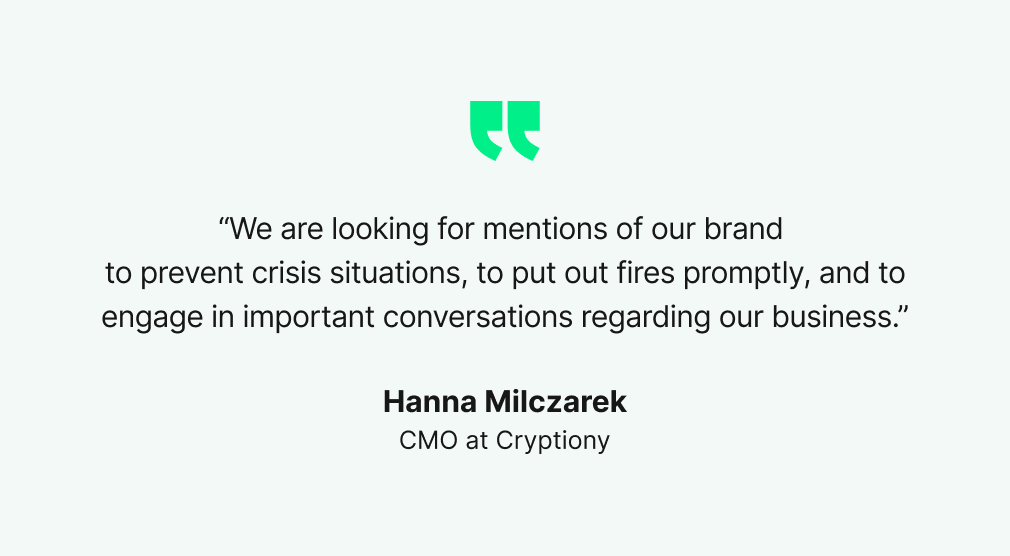
Discover our client’s success story — read the case study.
The goal is to provide clear, accurate, and consistent information to maintain trust and control the narrative before it gets out of control.
At this point, let’s differentiate between a crisis and an incident. Because not every situation constitutes a crisis that requires a full-blown response.
A crisis is an event you can’t predict that dangers the company’s reputation and can have a negative impact on its stakeholders.
What makes a crisis dangerous is that it has the potential to harm your company seriously. It can swiftly leak to the outside world, quickly escalate, and painfully hit your organization.
The incident, on the other hand, concerns any internal threats to your company. You don’t have to include your crisis response team. Just loop them in when the situation gets out of control.
Crisis communication entails all issues that could negatively impact your brand reputation, for example, HR complaints, product shortages, or litigation.
Detect crisis fast!
What is a crisis communication plan?
PwC’s Global Crisis and Resilience Survey shows that 96% of organizations faced disruptions in the last two years.
Also, 9 out of 10 of these organizations faced crises that had nothing to do with the COVID-19 pandemic.
This means that the question is not whether the crisis will hit your brand but rather when it will happen. And this means you should create a crisis communications plan.
It’s a set of rules your business should follow while facing a business crisis.
Usually, crisis communication covers three parts:
- A plan of action for when the crisis hits,
- Guidelines on how to communicate with the public,
- Steps on how to prevent the crisis from happening again.
The plan should list how you will communicate with your stakeholders — employees, shareholders, customers, general media, and partners.
A vital part of crisis communication is transparency. You have to ensure every stakeholder is on the same page — knows the state of the affairs and the steps the business takes to fight the crisis.
Why do you need a plan?
Without a plan, you’re essentially flying blind. You risk providing mixed messages, losing public trust, and worsening the situation. A plan ensures everyone knows their role and what actions to take.
And how many crisis communication plans should you have?
Ideally, for every crisis that can hit your brand, such as product issues, financial troubles, cyberattacks, social media mishaps, or customer service failures.
Tailor your crisis communications plan!
10 steps to create an effective crisis communication plan
01 Define the objective of the plan
Before you list the stakeholders and draft press releases, think about the goal of your crisis communication plan. Setting a goal will ensure that every step of the plan aligns with it.
The main objective of crisis communication is to develop a communication structure for internal and external stakeholders.
The communication plan should be implemented in a time of crisis that threatens the normal functions of an organization.
When defining the objective, consider the following key aspects:
- Minimize Damage. The plan should aim to limit the impact of the crisis on your brand’s reputation, financial performance, and operations.
- Ensure Transparency and Consistency. The goal is to communicate consistently and transparently across all channels, ensuring that all internal or external stakeholders know and understand the whole situation.
- Maintain Trust. The ultimate goal of crisis communication is to maintain or regain the trust of your audience by demonstrating that the organization is taking responsible, proactive steps to address the issue.
- Support Decision-Making: The communication plan should help leadership make informed decisions by ensuring they can access real-time information and insight into the crisis performance.
By defining these specific objectives at the beginning, you can be more sure that every element of your crisis communication strategy is aligned with the organization’s overall goal of reducing harm and maintaining long-term credibility.
Use Brand24 to detect crises at an early stage!
02 Identify the crisis management team
Everyone must know their role and the appropriate communication channels in a crisis. The crisis team should be small but mighty, consisting of key decision-makers who can act quickly and efficiently.
Above all, pick a crisis management leader. Such a person is like a firefighter commander who coordinates the crisis management process.
Also, designate a spokesperson. You need a person responsible for communication with the stakeholders.
The spokesperson can be your CEO, public relations manager, or anyone who can handle tough questions and work well under pressure.
Crisis Communications Example: Boeing
On January 2024, an Alaska Airlines Boeing 737 MAX 9 experienced a mid-flight emergency landing.
This incident led to the grounding of all 737 MAX 9 aircraft in the United States, triggered investigations into Boeing’s manufacturing practices, and raised serious concerns about the safety of the aircraft model.
Boeing implemented a crisis management plan based on transparency under the leadership of its CEO, Dave Calhoun.

Calhoun didn’t play ostrich and stood at the forefront of the crisis, addressing both the media, the politicians, and key stakeholders.
While Boeing’s reputation has undoubtedly suffered, it would have been much worse without the CEO’s leadership role in the company’s crisis response strategy.
Try Brand24 – the best crisis management tool!
03 Conduct a risk assessment
Before a crisis hits, it’s worth asking yourself one crucial question: what could go wrong? A comprehensive list of possible crisis scenarios is essential for targeted planning.
Different organizations are exposed to unique risks depending on their niche, size, and operational scope.
So, what kinds of crises are most likely to affect your organization? Are these natural disasters? Cyber threats? Damaging social media fallout?
Each type of threat requires a tailored communication and crisis management plan.
For instance, in the case of cyber threats, a quick response involving IT teams and cybersecurity experts is essential, along with transparent communication to customers about data breaches or compromised systems.
However, for natural disasters, the focus shifts to employee safety, operational continuity, and contacting the emergency services immediately.
Crisis Communications Example: Maersk
In June 2017, Maersk – one of the tycoons in shipping and logistics – experienced a massive ransomware attack that shut down its global operations.
Despite the scale of the crisis, Maersk had a plan to reduce its impact and restore operations quickly.
Thanks to a backup server in Ghana, the company restored its complicated system in less than ten days.
As for brand reputation crisis management efforts, Maersk prioritized proactive communication and immediately informed and updated its customers & stakeholders about the whole situation.
Their quick, transparent response helped rebuild trust and demonstrated the effectiveness of their crisis management plan.
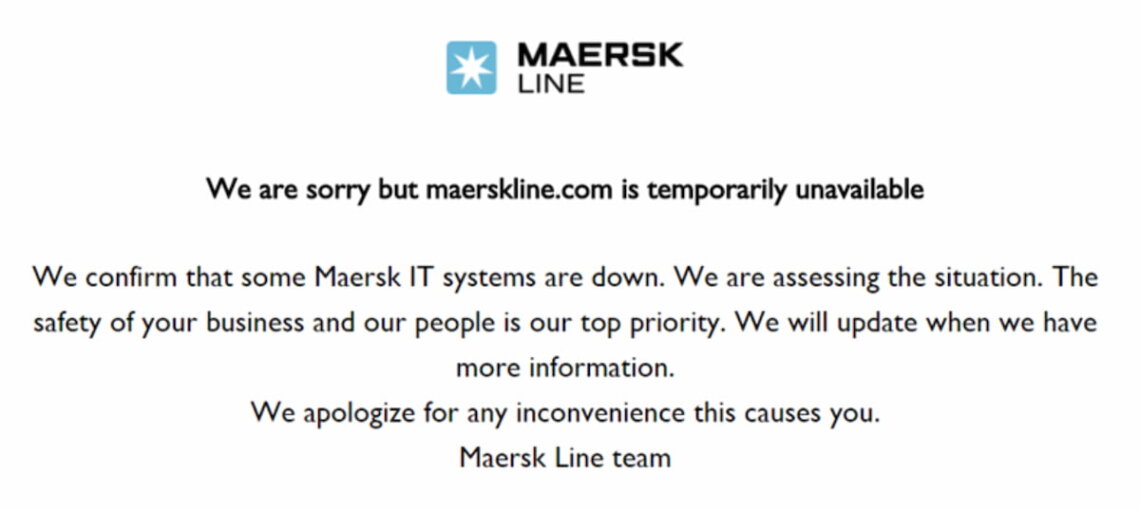
Use Brand24 to detect crises at an early stage!
04 Think over your messaging style
The core of crisis communications lies in the message.
Ask yourself one question: when the crisis occurs, what precisely will you say?
Pre-draft templates for press releases, internal memos, and social media posts to help expedite the communication process during a crisis.
Here’s how to write a trustworthy message:
- Be clear and concise. Avoid jargon and write in a language easily understood by your target audience. Clarity is vital in crisis communications.
- Leave room for customization. While the template serves as a skeleton, each crisis is unique. Leave placeholders where specific information can be inserted.
- Cover the 5 Ws. Who is impacted? What is the situation? Where did it happen? When did it happen? Why is this a concern? These questions should be addressed in the template.
- Tone matters. The tone should be empathetic, transparent, and aligned with the brand’s values.
Crisis communications example: Slack
While I don’t know if Slack used templates for crisis communication (that’s internal knowledge I don’t have access to), I admire how they acknowledged their audience during a service outage.
In short, in February 2022, Slack – a team communication platform – experienced a major disruption. The app was down for about three hours, affecting users worldwide.
During the outage, Slack communicated honestly with users. It simply displayed a message: “Sorry, we can’t be more specific—this is one of those cases where we don’t know what’s gone wrong either.”
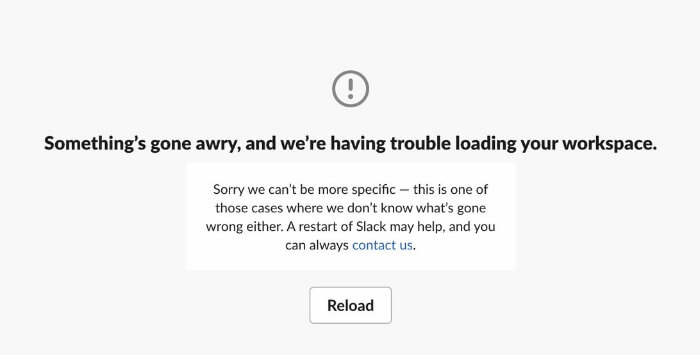
Their post-crisis communication maintained this honest and lighthearted tone. Frankly, it was hard to be mad at them!
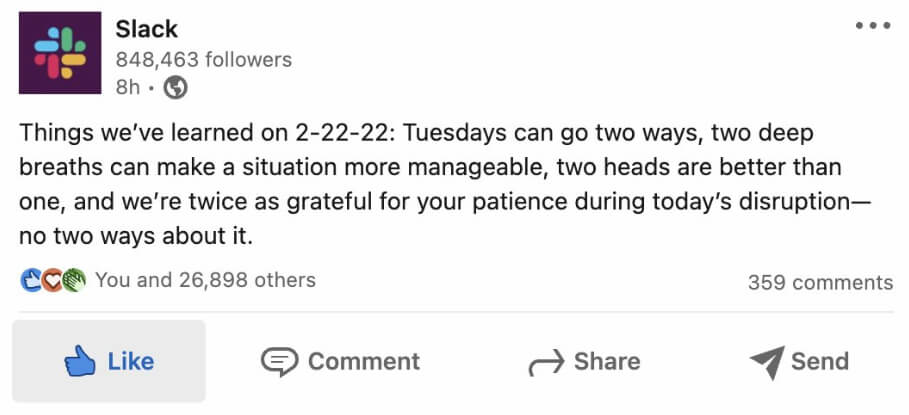
Check what makes your audience angry & adjust your messaging!
05 Implement monitoring tools
Crisis communication is not only about talking. It’s also about listening!
You simply have to know what people are talking about when it comes to your brand, product, or service. That’s essential for creating crisis management strategies!
OK, but how do you do it in practice? How to listen?
Firstly, you can simply enter your brand’s name into a search engine and track what people say about you. But unfortunately, it’s a highly ineffective method. There are so many sources to follow!
Secondly, you can use a media monitoring tool like Brand24.
It works as follows: Brand24 constantly crawls the web and detects public mentions of your brand.
The tool accesses multiple online sources:
- Social media (Facebook, Instagram, YouTube, TikTok, X, LinkedIn, Reddit, Telegram, Twitch, etc.)
- News media sites, video platforms, podcasts, forums, review sites, newsletters, blogs & other websites.
Detecting brand mentions is just the first step. Brand24 offers amazing analytics features that provide hundreds of valuable insights!
Regarding crisis recognition and communication, one of the most important ones is sentiment analysis.
In short, a sentiment analysis automatically recognizes the emotions behind brand mentions and rates mentions as positive, negative, or neutral.
Sure, a single negative mention doesn’t indicate a crisis. But when the volume of negative comments increases, it’s a red flag!
Take a look at Rockstar Games’ sentiment chart from September 2024. Oops, something is definitely going wrong!
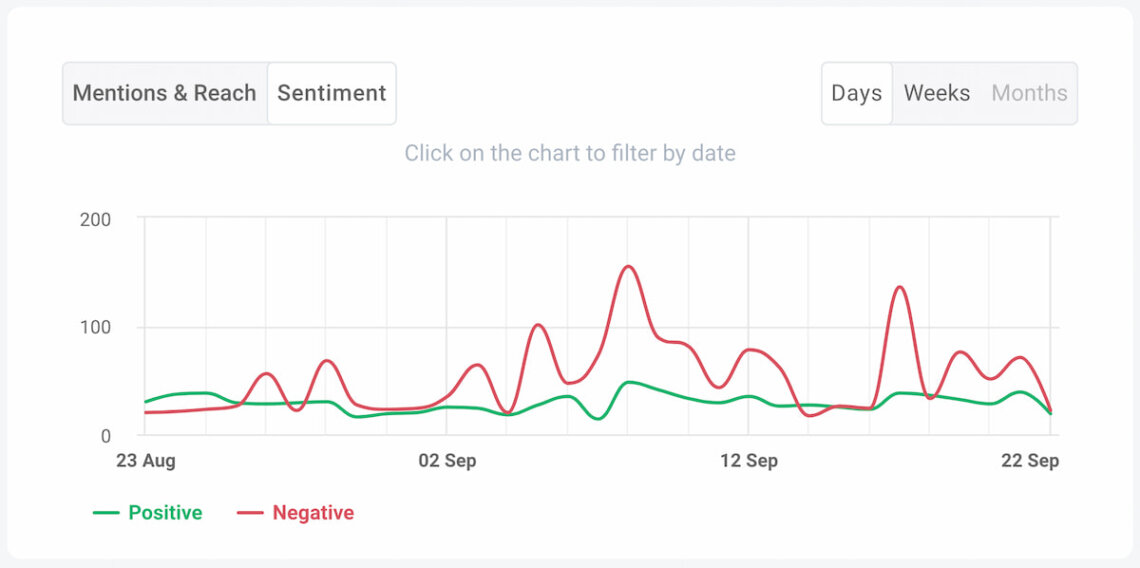
To discover what caused those negative spikes for this video game development brand, I decided to use another Brand24 feature called the AI Anomaly Detector.
In short, the Anomaly Detector recognizes unusual patterns in your project (i.e., increased negativity) and searches for the reason.
Ultimately, it presents its conclusion in 1 – 2 essential sentences.
As you can see below, the rise of negativity from September 8th was caused by the delay rumors and controversy over the low music licensing offer for GTA 6 (the most anticipated game in the world).
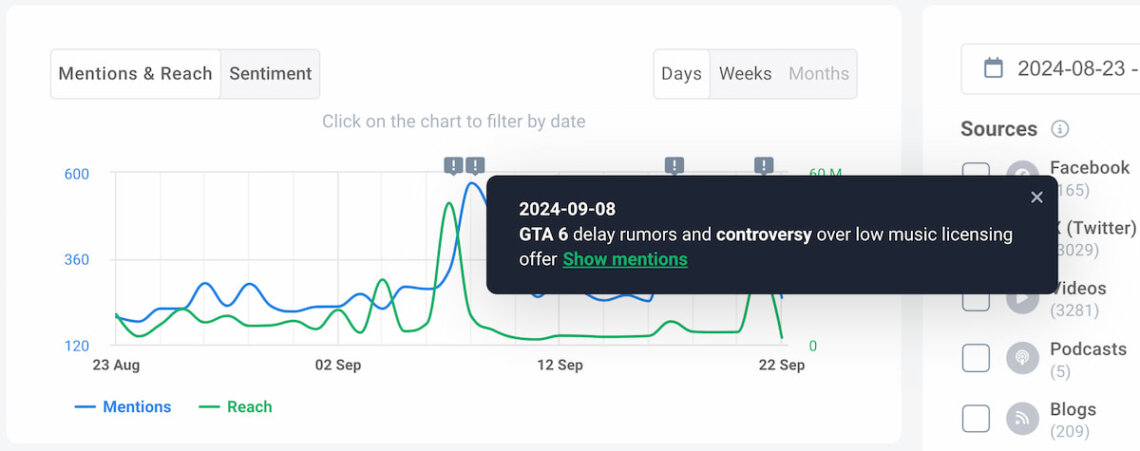
The Reputation Score is another useful Brand24 feature for preventing (or quickly recognizing) a brand reputation crisis.
It is a metric that operates on a scale from -100 to 100, where 100 is extremely good. When positive mentions overwhelm negative ones, the score increases.
On the other hand, if your Reputation Score suddenly drops, it’s probably the right time to start crisis communications.
Obviously, Rockstar Games is doing poorly, and things are getting even worse. Maybe it’s time to proceed with some corrective actions.

Last but not least, there are Storm Alerts.
In short, whenever something unusual happens with your brand’s online presence – such as a sudden increase in negative mentions – Brand24’s Storm Alerts will notify you instantly.
This allows you to take immediate action before the situation spirals out of control.
Alerts are customizable, so you can set specific conditions for when you want to be alerted.
Storm Alerts are especially valuable when managing crises in real time. You can address the root causes, adjust your messaging, or provide necessary clarifications. Fast.
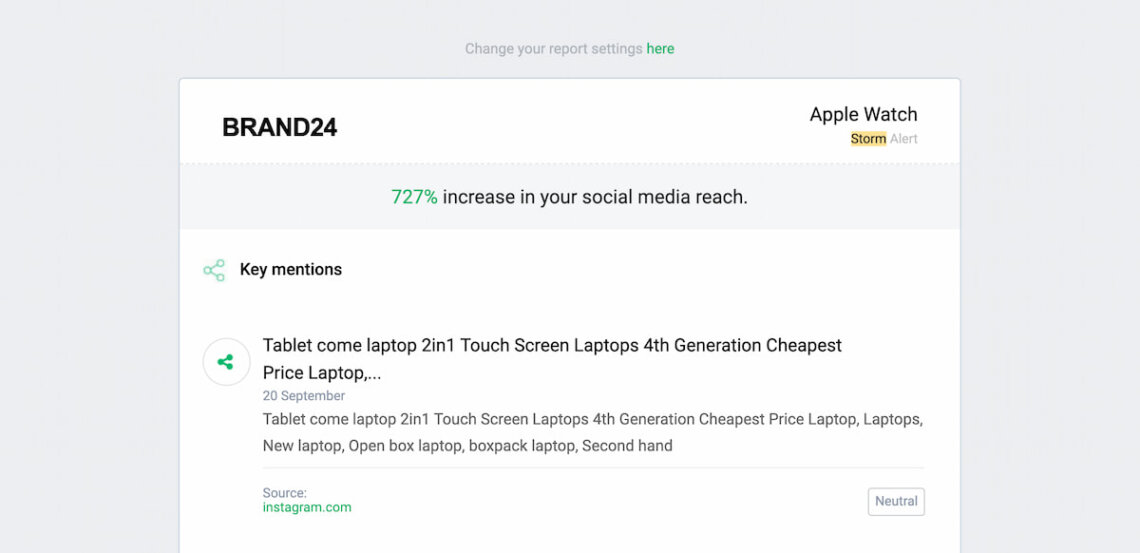
Use Brand24 and detect crises at an early stage!
06 Create a chain of command
Have you ever taken a first aid course? If not, I strongly recommend you do one.
You can save someone’s life in a dangerous situation and gain priceless knowledge of how to manage a crisis and create a chain of command.
A company in crisis is like a man lying on the ground. When you spot it, you must know what to do. That’s where the chain of command comes in handy.
A hierarchy of information will ensure that the crisis is addressed quickly. This allows you to fight it before it hits the fan.
The order depends on your company’s structure.
In flat-structure organizations, you can go directly to your CEO.
When you work in a hierarchical structure, you should probably go to your supervisor first.
Crisis communication plans should indicate what information should be disclosed to each party.
A single negative mention can start a crisis! Don’t miss it!
07 Remember about social media
Social media channels play a crucial role in crisis communications.

Discover our client’s success story — read the case study.
They serve as a powerful tool for sharing information, managing public perception, and enabling communication between organizations and the public during a crisis.
When used wisely, social media can help you provide regular updates about the evolving situation, including steps being taken to address the crisis.
But on the other hand, social media can pose certain risks during crisis management:
- Misinformation and rumors. Social media platforms can be breeding grounds for spreading misinformation, rumors, and false information during a crisis.
- Lack of control. Once information is posted on social media, users can share and reshare it, potentially making it go viral.
- Negative comments. Emotions can run high in a crisis, and people might express anger, frustration, or criticism on social media. Negative comments and backlash can quickly escalate and damage an organization’s reputation if not managed appropriately.
A proactive strategy is crucial for mitigating these risks. The good news is that it doesn’t have to be complicated!
I suggest you to prioritize three steps:
- Implement a real time social media monitoring.
- Correct misinformation swiftly.
- Maintain consistent messaging.
Besides, remember to ensure that your crisis team is ready to respond quickly and calmly to any negative comments, guiding the conversation in a constructive direction.
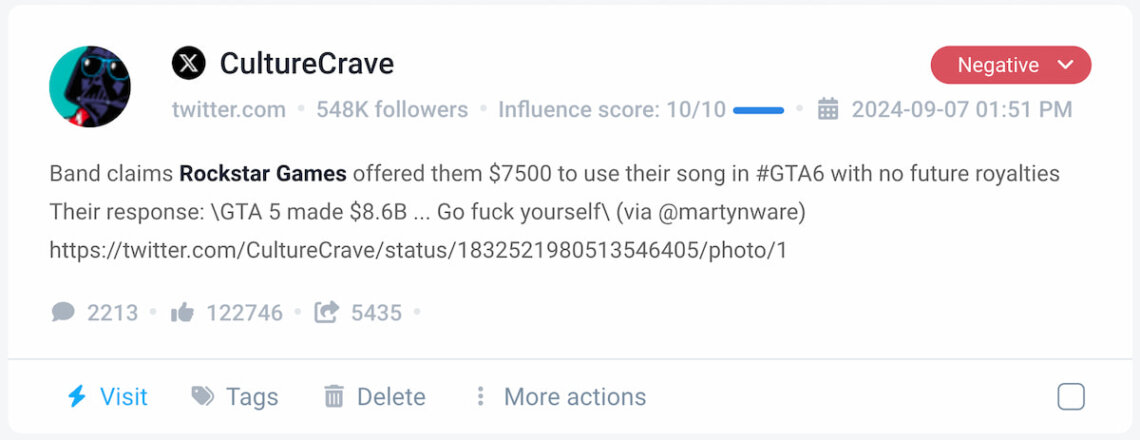
Crisis communications example: KFC
In 2018, KFC in the United Kingdom experienced a supply chain problem that led to hundreds of stores running out of chicken. People were angry, and complaints flooded social media.
Instead of remaining silent, KFC took control of the narrative.
The company quickly acknowledged the issue and used humor and humility in their communications. KFC’ created one of the most iconic apologies ever – a full-page newspaper ad with an empty chicken bucket labeled “FCK”.
It became a central talking point across social platforms. According to Campaign Live, the “chicken crisis” response could have reached over 1 billion people!
It’s a pure masterclass in effective crisis communication!

Try the best social media monitoring tool!
08 Train for the crisis
When a crisis appears, you might feel overwhelmed by the amount of information you must process and the number of decisions you need to make.
But you can implement a drill and train for the most common scenarios. That way, you will ensure that everybody knows what they are doing and will not be caught off guard.
In practice, you could train your organization by focusing on the following issues:
- Identify potential crisis scenarios that your organization could face.
- Determine the key roles and responsibilities within the crisis communication team.
- Train spokespeople on how to project calmness and empathy during crisis situations.
- Conduct crisis simulation exercises to practice how your team would respond to various crises.
- Train your team on using various communication tools, such as social media platforms, press release templates, and email.
- Outline the procedures for escalating a crisis to higher management or decision-makers when necessary.
- Analyze past crises within your organization and similar industries to identify lessons learned and best practices.
Use Brand24 to detect crises at an early stage!
09 Expect unexpected
You can do everything right and still encounter unexpected events. The goal of a crisis communication plan is to minimize the damage.
But even the best communication plan can backfire. You have to expect that not everything will go smoothly and be mentally prepared for every possible scenario.
Crisis communications example: Tide
In 2018, Tide – the brand under the Procter & Gamble company – faced an unexpected “Tide Pod Challenge” crisis.
Teenagers were filming themselves eating Tide Pods (the colorful laundry detergent capsules) as part of a dangerous social media trend.
Despite its solid reputation and established safety protocols, Tide found itself in a PR crisis. It simply didn’t suspect that eating laundry detergent might become viral!
Tide quickly responded by working with social media platforms to remove harmful content and issued public statements emphasizing the dangers of ingesting the product.
The brand even asked NFL player Rob Gronkowski to create a video urging people not to participate in the challenge.
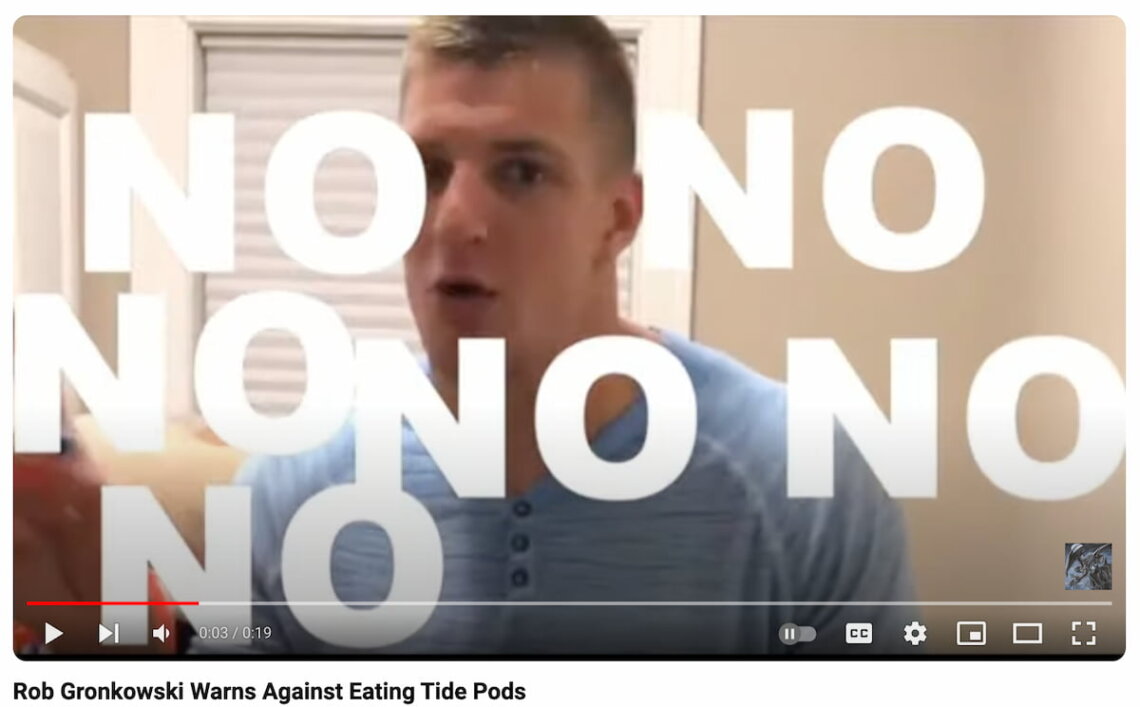
Despite having a robust communication plan, this unexpected event showed how a brand must remain agile and ready to adapt.
Tide’s quick action helped mitigate the situation, but the incident highlighted the importance of expecting the unexpected.
With Brand24, you will combat any crisis!
10 Review and update
Ultimately, you should regularly review and update your crisis communication plan. How often?
It depends on how rapidly your organization’s environment changes.
During such a review, you should:
- Identify new potential crisis scenarios that have emerged since the last review.
- Evaluate changes in the industry, technology, regulations, and public sentiment that could impact your organization’s risk landscape.
- Review any past crisis situations your organization has faced since the last plan update.
- Evaluate the effectiveness of communication channels used in the previous plan and determine whether new platforms or channels have become more relevant or popular.
- Consider the role of social media, internal communication tools, traditional media, and other relevant channels.
- Review and update message templates.
- Assess the tools used for communication, monitoring, and analysis during a crisis.
Use Brand24 to detect crises at an early stage!
Gamechanger tip: Utilize AI tools!
To develop effective crisis communications, there is one more thing you can do: ask AI for help!
Let me get this straight – AI can analyze large amounts of data in real time much faster than any analyst, detect potential crises earlier than top public relations specialists, and suggest solutions even the most experienced strategist would come up with.
Don’t get me wrong. I do not claim that artificial intelligence will do the job for you. Human creativity and problem-solving are irreplaceable in handling crises, especially when you have to navigate complex emotions.
But AI can be an incredible tool in your crisis management arsenal.
You can use it for:
- Predictive analytics. AI can analyze historical data and identify patterns that may indicate the upcoming brand crisis.
- Real time monitoring. We discussed it the paragraph number 5, so I won’t repeat it here.
- Automated responses. You can set up an AI chatbot to provide immediate & pre-approved responses to common queries during a crisis.
- Crisis simulations. AI can be used to simulate crisis scenarios, making your crisis preparations more accurate.
Okay, and which software should you use?
I strongly recommend you pick these AI tools that have access to detailed internal data about your brand or company. This way, you ensure that the AI-generated insights are individually tailored and relevant.
For example, Brand24 offers a very interesting AI feature called Brand Assistant.
In short, it’s a chatbot you can ask about anything related to your brand or industry.
With its internal knowledge of your project, the Brand Assistant can generate very accurate observations, conclusions, and suggestions.
Crisis communications example: Rockstar Games
To demonstrate how AI capabilities could be used in practice, let’s consider uncovering and resolving the hypothetical Rockstar Games crisis.
I asked the AI Brand Assistant which topic generates the most extensive negative sentiment toward the brand. According to Brand Assistant, it’s GTA 6 leaks and controversies.
In other words, Rockstar Games faces problems with information security.
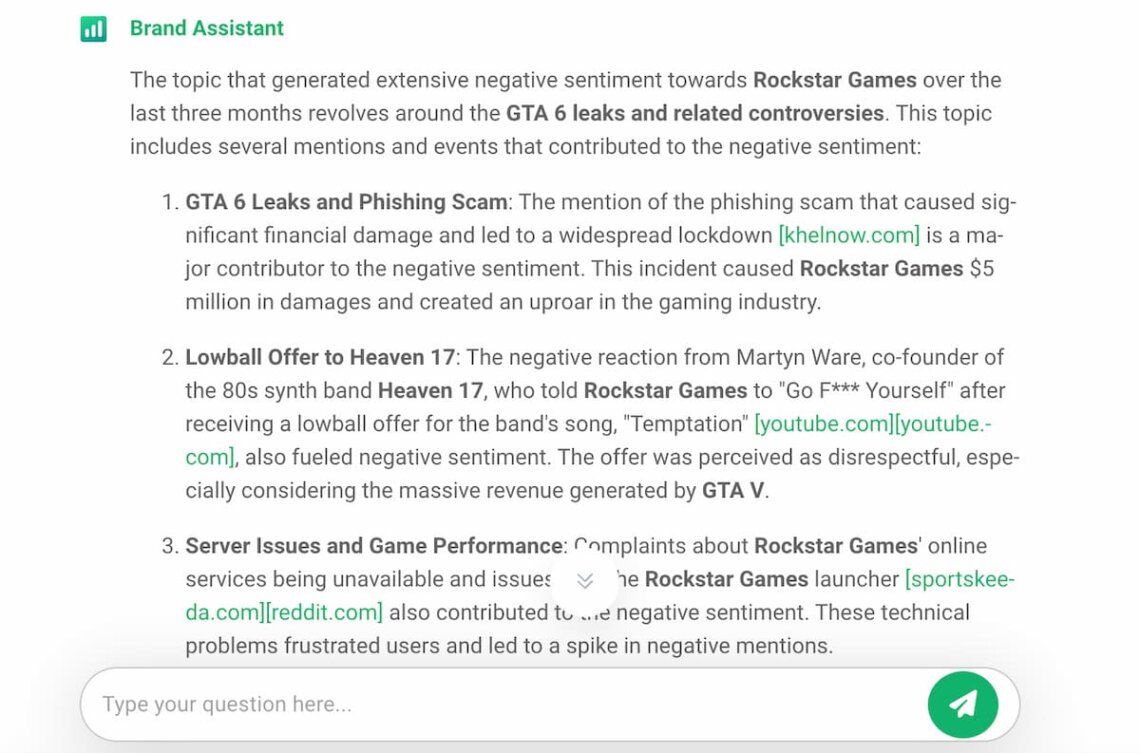
I typed a follow-up prompt asking for generating a crisis communications plan for this situation.
The Brand Assistant suggested a timeline of steps to take along with example statements Rockstar Games could use in their communications. Nice!

Try AI Brand Assistant now!
Conclusion
Crisis communication examples in this article prove that every business – no matter its size or industry – must be prepared to handle crises effectively.
Well-structured crisis management plans are essential for navigating these challenging moments, minimizing damage, and maintaining stakeholder trust.
By clearly defining roles, identifying risks, and ensuring transparency, you can mitigate the potential harm of a crisis.
Regularly reviewing and updating the plan ensures it remains relevant as the business and external landscape evolve.
Remember, crises can happen unexpectedly, so preparation is key. With the right crisis communication plan in place, your brand will be better equipped to not only survive a crisis but also emerge stronger.
Read more & take crisis control.
Final thoughts:
- Crises are inevitable, so every business must be prepared. At the same time, you must stay agile because unexpected things can happen anytime.
- How you react to a crisis can impact your brand’s reputation for years. A thoughtful response can preserve trust, while a poorly managed crisis can lead to long-term damage.
- Crisis communication is not only about talking but also about listening – including social listening. You must know what people say about your brand to address issues quickly and effectively.
- AI tools can detect crises quickly and streamline your crisis communication.
Minimize the risk of crisis and react quickly when it emerges! Start Brand24’s free trial now!
Related articles



![How to do Social Media Sentiment Analysis in 2025? [Easy Guide, Benefits & More!]](https://brand24.com/blog/app/uploads/2023/03/social_media_sentiment_analysis_brand_image_blog_cover_615x345-600x335.webp)

![How to Measure PR Performance? [2025]](https://brand24.com/blog/app/uploads/2024/05/pr_performance-600x335.webp)
![7 Social Listening Examples From Inspiring Brands [2025]](https://brand24.com/blog/app/uploads/2025/05/social_listening_examples_blog_cover_615x345-600x335.webp)